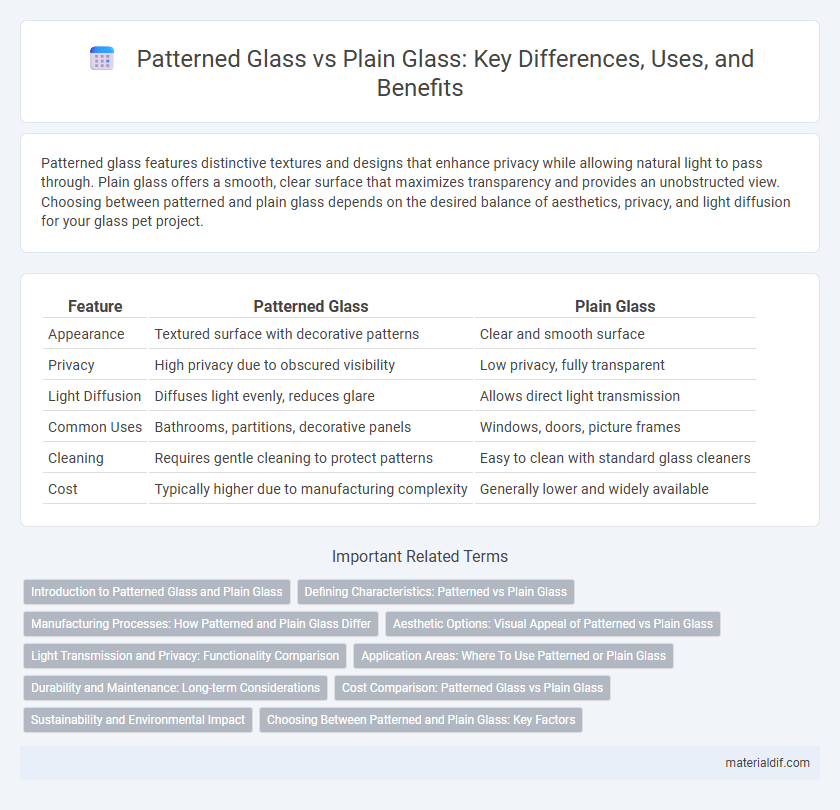Patterned glass features distinctive textures and designs that enhance privacy while allowing natural light to pass through. Plain glass offers a smooth, clear surface that maximizes transparency and provides an unobstructed view. Choosing between patterned and plain glass depends on the desired balance of aesthetics, privacy, and light diffusion for your glass pet project.
Table of Comparison
| Feature | Patterned Glass | Plain Glass |
|---|---|---|
| Appearance | Textured surface with decorative patterns | Clear and smooth surface |
| Privacy | High privacy due to obscured visibility | Low privacy, fully transparent |
| Light Diffusion | Diffuses light evenly, reduces glare | Allows direct light transmission |
| Common Uses | Bathrooms, partitions, decorative panels | Windows, doors, picture frames |
| Cleaning | Requires gentle cleaning to protect patterns | Easy to clean with standard glass cleaners |
| Cost | Typically higher due to manufacturing complexity | Generally lower and widely available |
Introduction to Patterned Glass and Plain Glass
Patterned glass features textured designs that enhance privacy and diffuse light while adding decorative appeal, making it ideal for bathrooms and office partitions. Plain glass offers a smooth, transparent surface that maximizes visibility and natural light, commonly used in windows and picture frames. Choosing between patterned and plain glass depends on aesthetic preferences and functional requirements such as light control and privacy levels.
Defining Characteristics: Patterned vs Plain Glass
Patterned glass features textured or embossed surfaces designed to obscure visibility while allowing light to pass through, making it ideal for privacy applications in windows and doors. Plain glass, also known as clear or float glass, offers a smooth, transparent surface that provides unobstructed views and natural light, commonly used in storefronts and picture windows. The defining characteristic of patterned glass lies in its decorative or functional surface patterns, whereas plain glass is characterized by its uniform, flat, and transparent nature.
Manufacturing Processes: How Patterned and Plain Glass Differ
Patterned glass is produced by rolling molten glass over engraved rollers, imprinting distinctive textures and designs onto its surface during the manufacturing process. Plain glass, in contrast, is made by floating molten glass on a bed of molten tin, resulting in a smooth, flat surface without texture. These distinct techniques influence the tactile qualities, light diffusion, and visual aesthetics of patterned versus plain glass.
Aesthetic Options: Visual Appeal of Patterned vs Plain Glass
Patterned glass offers diverse aesthetic options with intricate textures and designs that enhance visual interest and provide privacy without sacrificing light transmission. Plain glass delivers a sleek, minimalist appearance, maximizing transparency and clarity for an unobstructed view. Choosing between patterned and plain glass depends on the desired balance of decorative detail and simplicity in architectural or interior design projects.
Light Transmission and Privacy: Functionality Comparison
Patterned glass diffuses light to enhance privacy while maintaining moderate light transmission, making it ideal for spaces requiring subdued visibility without sacrificing brightness. Plain glass offers maximum light transmission with clear visibility, suitable for areas where unobstructed views and natural light are priorities. The choice between patterned and plain glass depends on balancing privacy needs with the desire for natural illumination.
Application Areas: Where To Use Patterned or Plain Glass
Patterned glass is ideal for applications requiring privacy and decorative appeal, such as bathroom windows, shower enclosures, and office partitions, where diffused light and obscured views are beneficial. Plain glass suits areas needing clear visibility and unobstructed views, including storefronts, glass doors, and picture windows, enhancing natural light and providing a transparent barrier. Selecting between patterned and plain glass depends on the balance between privacy needs and visual clarity in residential or commercial spaces.
Durability and Maintenance: Long-term Considerations
Patterned glass typically offers enhanced scratch resistance compared to plain glass due to its textured surface, contributing to greater durability in high-traffic or commercial environments. Maintenance of patterned glass is often easier as its design can mask minor blemishes and fingerprints, reducing the frequency of intensive cleaning. Plain glass, while simpler to clean with fewer crevices, may show wear and scratches more readily over time, potentially increasing maintenance efforts in long-term use.
Cost Comparison: Patterned Glass vs Plain Glass
Patterned glass generally costs more than plain glass due to the additional manufacturing processes involved, including embossing or etching designs. Plain glass is more affordable, making it a preferred choice for projects with tight budgets or large surface areas requiring uniform transparency. When choosing between patterned and plain glass, consider the balance between aesthetic appeal and cost efficiency to meet specific design and budget requirements.
Sustainability and Environmental Impact
Patterned glass enhances sustainability by reducing the need for additional curtains or blinds, promoting natural light diffusion and lowering energy consumption for lighting and cooling. Its manufacturing process often incorporates recycled materials, contributing to resource efficiency compared to plain glass. Plain glass, while versatile, generally lacks the energy-saving benefits of patterned glass, making patterned glass a more eco-friendly choice in sustainable building design.
Choosing Between Patterned and Plain Glass: Key Factors
Choosing between patterned and plain glass depends on factors such as privacy requirements, design aesthetics, and light diffusion. Patterned glass offers enhanced privacy and decorative appeal by obscuring visibility while allowing natural light, making it ideal for bathrooms and office partitions. Plain glass provides unobstructed views and maximum transparency, suitable for areas where clear sightlines and minimalist design are prioritized.
Patterned glass vs Plain glass Infographic

 materialdif.com
materialdif.com